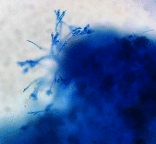Absence of cutaneous involvement in disseminated Talaromyces marneffei infection in an AIDS patient: a case report and literature review
- PMID: 31239726
- PMCID: PMC6556212
- DOI: 10.2147/IDR.S207819
Absence of cutaneous involvement in disseminated Talaromyces marneffei infection in an AIDS patient: a case report and literature review
Abstract
Background: Talaromyces marneffei (T. marneffei) is an important opportunistic pathogen found in human immunodeficiency virus-positive individuals in Southeast Asia, Southern China, and Northeastern India. Patients with disseminated talaromycosis commonly develop multi-organ involvement including the skin. In this report, we describe the clinical presentation, investigation, management, and clinical outcome of an acquired immune deficiency syndrome (AIDS) patient with newly diagnosed disseminated talaromycosis without skin involvement.
Case presentation: A 27-year-old male with AIDS presented with acute onset of abdominal pain for 4 days and fever for 2 days. He had been diagnosed with AIDS, pneumocystis pneumonia, and presumptive smear-negative pulmonary tuberculosis 2 months previously. His initial CD4 count was 91 cells/mm3. After a 3-week course of trimethoprim/sulfamethoxazole and anti-tuberculosis treatment, anti-retroviral therapy was initiated. Physical examination revealed left upper quadrant tenderness but no abnormal skin lesions. On this visit, his CD4 count rose to 272 cells/mm3 (19%). Computed tomography of the abdomen showed evidence of a small hypodense lesion with a thin enhancing rim at the spleen and extensive intra-abdominal lymphadenopathy. Empirical amphotericin B deoxycholate was administered in response to positive serum galactomannan, although this was switched to intravenous liposomal amphotericin B 1 week later because of acute kidney injury. Blood and bone marrow cultures for fungus grew T. marneffei on days 9 and 12, respectively. After 21 days of treatment, oral itraconazole replaced intravenous therapy. The patient was discharged home after 29 days in the hospital and continued to improve clinically at a follow-up visit as an outpatient.
Conclusion: Talaromycosis is a fairly common opportunistic infection among AIDS patients in Thailand, despite a rise in CD4 count which may reflect a change in immune status. To a lesser extent, a systemic disease without skin involvement can be expected in real clinical practice.
Keywords: AIDS; cutaneous involvement; disseminated fungal infection; talaromycosis.
Conflict of interest statement
The authors declare that they have no competing interests in this work.
Figures




References
-
- Piehl MR, Kaplan RL, Haber MH. Disseminated penicilliosis in a patient with acquired immunodeficiency syndrome. Arch Pathol Lab Med. 1988;112:1262–1264. - PubMed
-
- Supparatpinyo K, Khamwan C, Baosoung V, Nelson KE, Sirisanthana T. Disseminated Penicillium marneffei infection in Southeast Asia. Lancet. 1994;344:110–113. - PubMed
-
- Wong KH, Lee SS, Chan KC, et al. Redefining AIDS: case exemplified by Penicillium marneffei infection in HIV-infected people in Hong Kong. Int J STD AIDS. 1998;9:555–556. - PubMed
Publication types
LinkOut - more resources
Full Text Sources
Research Materials

